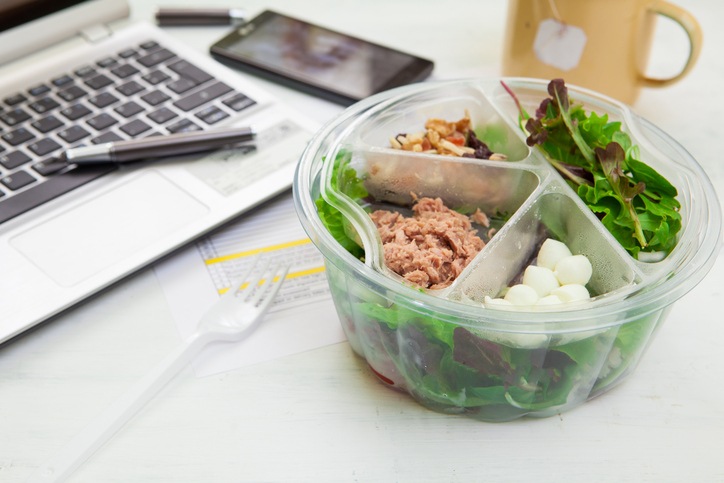When you’re working absolutely all the time, one of the first things sacrificed to work efficiency is your diet. You could get another hour of work done, who has time to steam vegetables, lightly grill chicken, and boil a pot of noodles? Who even has time to scramble an egg? All too often busy professionals find themselves eating nothing but fast food and unhealthy packaged meals again and again. Soon your health (and your waistline) begin to show the evidence and you know you need to change… you just don’t have the time.
While the deskercising trend is rising in popularity again, professionals are still having trouble maintaining a healthy nutritional balance. For energy and good digestion, you need three reliable meals full of vegetables, lean meat, and fibrous starch. For hours of hard brain work, you need greasy snacks, preferably full of protein, fat, and sugar. While your relationship with brain snacks is a personal one, the best way to stay healthy and busy at the same time is to minimize the prep time for healthy breakfasts, lunches, and dinners.
One Big Cookup
The key to optimizing a healthy home-cooked diet on an entrepreneur’s schedule is to do one or two big cook-ups a week, concentrating most of your prep time into a few dedicated hours possibly overlapping with something else you need to do like spend time with family or catch up on your podcasts. This is the perfect time to cook up a lot of meat, dice a lot of vegetables, and prepare easy to reheat ingredients that can become a hot healthy meal in about the time it takes to make a sandwich.
Breakfast Prep
Breakfast is the best time of day for fast, nutritious, and hot food. Some people don’t really get started in the morning until they’ve eaten something warm and with at least trace amounts of protein. Instant oatmeal is a great place to start but if you really want that all-day energy feeling, eggs are your best bet. To make delicious breakfast biscuits that will keep you fueled all week, preheat your oven to 350 F and start frying an entire pack of bacon. Scramble a dozen eggs in a mixing bowl and, optionally, add your favorite diced omelet ingredients. Pour the eggs into a muffin pan and bake until fluffy and set.
Now, every day you can combine an omelet disc, piece of bacon cut in half, and toast or a biscuit. Either toast the egg and bread separately or wrap the whole thing in a damp paper towel and microwave for quick and healthy homemade breakfast sandwiches all week long.
Lunch Prep
Everyone has a personal lunch preference, but your ideal plan is to have ingredients that can make several quick recipes based on your mood in the middle of the day. For instance, the meat and fixin’s for sandwiches and homemade salads are practically identical, just using different proportions and dishes. Lunch meat and canned meats are a great place to start but we suggest you cook up, season, and dice several large pieces of chicken early in the week and use it as a fast-protein ingredient throughout. For a quick hot lunch, consider toasted sandwiches or microwaved vegetable-rich soups.
Dinner Prep
What we eat for dinner will stay with us through the evening and into sleep. The tradition of a big, heavy dinner was set by people who worked labor-intensive jobs. For brain work, you need lean meat (chicken), healthy oil (fish) and a balance of vegetables to tend a digestive system that doesn’t walk miles every day. For big dishes, you can make chicken and vegetable soup or casseroles that can be reheated quickly in individual portions. You can also boil pasta ahead of time and serve it up with jarred pasta sauce and your stock of diced chicken or you can combine anything you like with chicken in a tortilla for a quick wrap meal.
No matter what your favorite recipes are, there is likely a way to prepare most of the ingredients ahead of time with one big dedicated cooking project early in the week. One or two hours spent in the kitchen per week can make a huge difference on your diet, your health, and your schedule. Simply plan for whatever you have to work with, whether it’s a microwave, a toaster oven, or even just an electric kettle. The key to lifestyle automation is simply to think strategically and do things in the right order.




